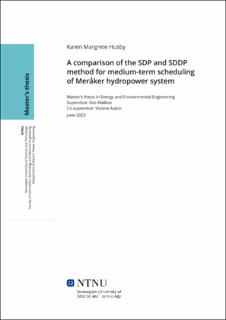| dc.contributor.advisor | Klæboe, Gro | |
| dc.contributor.advisor | Aubin, Viviane | |
| dc.contributor.author | Husby, Karen Margrete | |
| dc.date.accessioned | 2023-10-13T17:20:25Z | |
| dc.date.available | 2023-10-13T17:20:25Z | |
| dc.date.issued | 2023 | |
| dc.identifier | no.ntnu:inspera:146046472:35257649 | |
| dc.identifier.uri | https://hdl.handle.net/11250/3096524 | |
| dc.description.abstract | I dagens samfunn blir flere fornybare energikilder innført som en konsekvens av et ønske om å redusere klimautslippene. Ettersom flere av disse ikke kan kontrolleres, for eksempel er man avhenging av vind for å produsere vindkraft, er det viktig for samfunnet at vannmagasinene opereres på best mulig måte. For vannkraftprodusentene gjøres dette ved at en vannverdi settes på det magasinerte vannet. Vannverdien gir et estimat på hvilken pris man kan oppnå for elektrisiteten man produserer av vannet i magasinet.
For å bestemme vannverdien brukes en mellomlang vannkraftmodel, gjerne bygget på enten stokastisk dynamisk programmering (SDP) eller stokastisk dynamisk dual programmering (SDDP). I denne masteroppgaven bli SDP og SDDP metodene sammenlignet for å se hvilken av de som gir den beste bruken av vannet i testsystemet. Den beste bruken blir definert av mengden tapt vann og inntekt i de to modellene og oppfyllelsen av minstevannføringskravet i testsystemet.
Resultatene fra denne oppgaven viser at SDDP modellen har lavest tapt vann og størst inntekt og total verdi. Total verdi er summen av inntekt og verdien av sluttmagasin. Resultatene viser også at de to modellene oppfyller minstevannføringskravet likt. På grunn av dette og den høyere inntekten og lavere tapt vann i SDDP sammenlignet med SDP, kan det bli konkludert med at SDDP modellen gir den beste bruken av vannet i testsystemet. | |
| dc.description.abstract | In society today, more renewable energy sources are being introduced as a consequence of a desire to reduce climate emissions. As several of these renewables cannot be controlled, such as wind power which is dependent on the wind to produce, it is important that hydropower with stored water is utilized in the best possible way. For the hydropower producers, this is done by placing a water value on the stored water, which gives an estimate of the price that can be obtained for the electricity produced from the water in the future.
Setting the water values is done using a medium-term hydropower scheduling model, normally built using either stochastic dynamic programming (SDP) or stochastic dynamic dual programming (SDDP). In this master thesis, the SDP and SDDP methods are compared to see which of them gives the best usage of the water in the test case. The best usage is defined by the amount of income and spillage in the two models and the fulfillment of the minimum discharge constraint in the test case.
The results from this case study show that the SDDP model has the lowest spillage and the largest income and total value. Total value is the sum of income and the value of the end reservoir. The results also show that the two models equally fulfill the minimum discharge constraint. Because of this and the higher income and lower spillage in SDDP compared to SDP, it can be concluded that the SDDP model gives the best usage of the water in the test system. | |
| dc.language | eng | |
| dc.publisher | NTNU | |
| dc.title | A comparison of the SDP and SDDP method for medium-term scheduling of Meråker hydropower system | |
| dc.type | Master thesis | |
